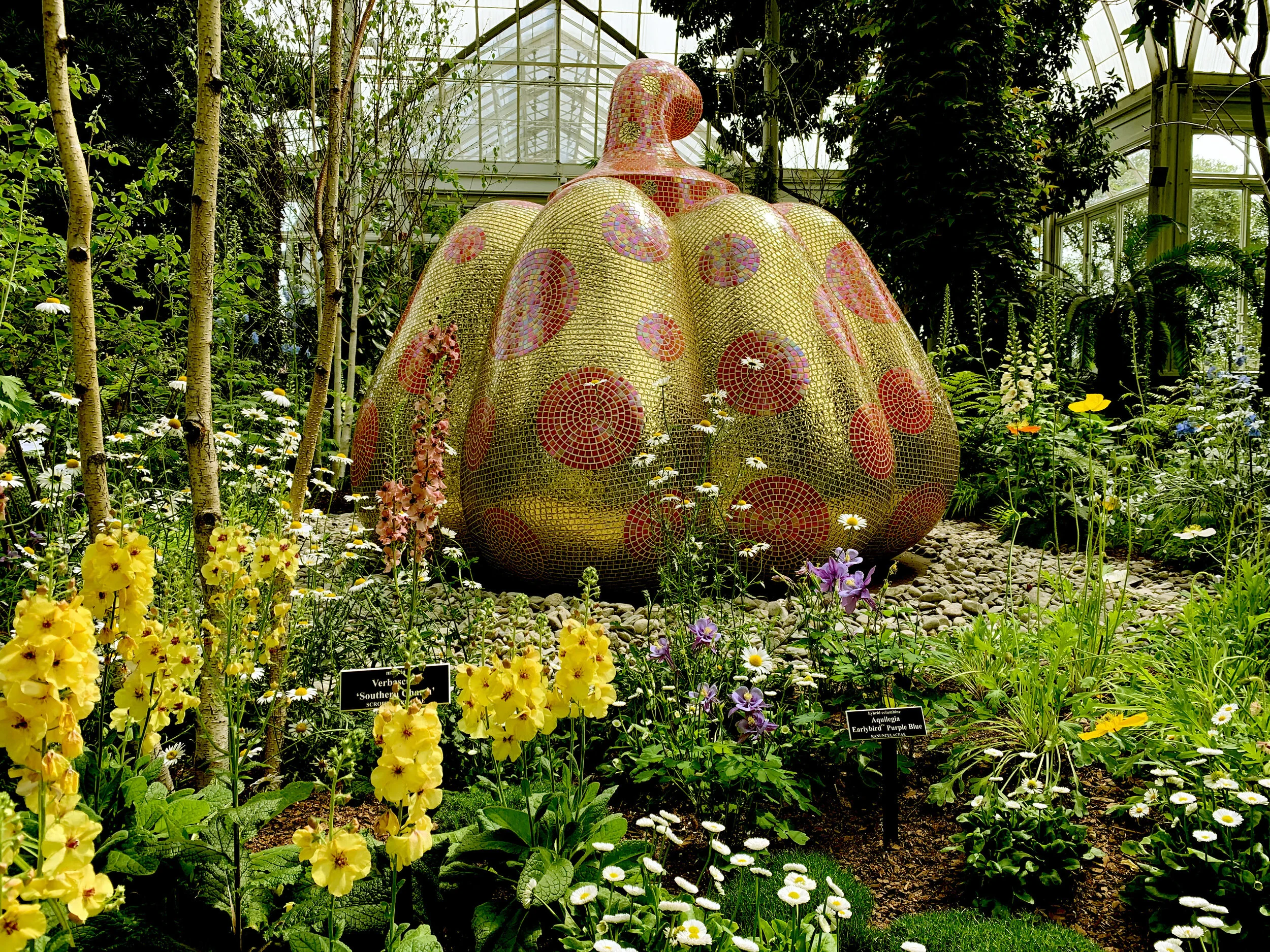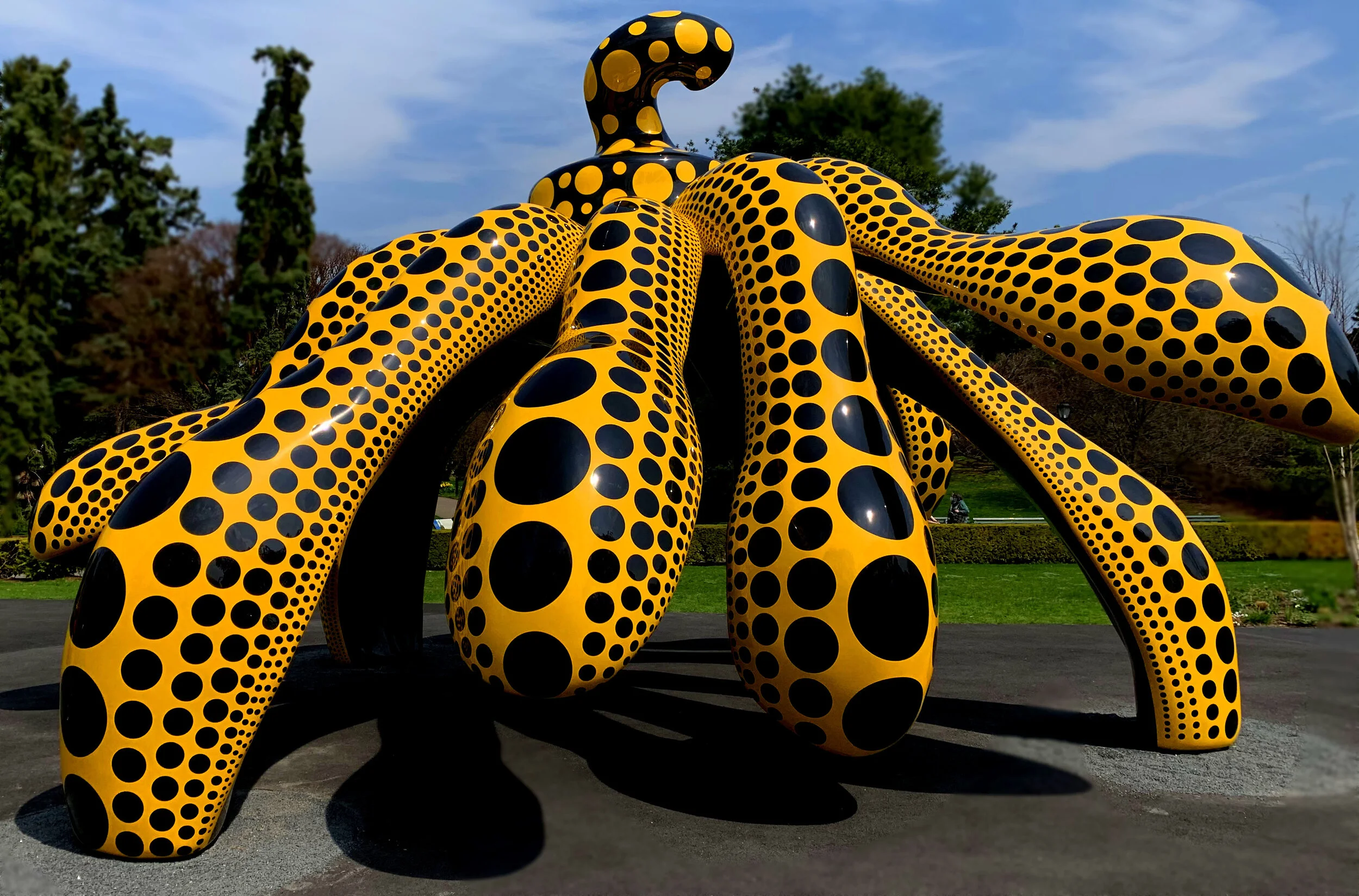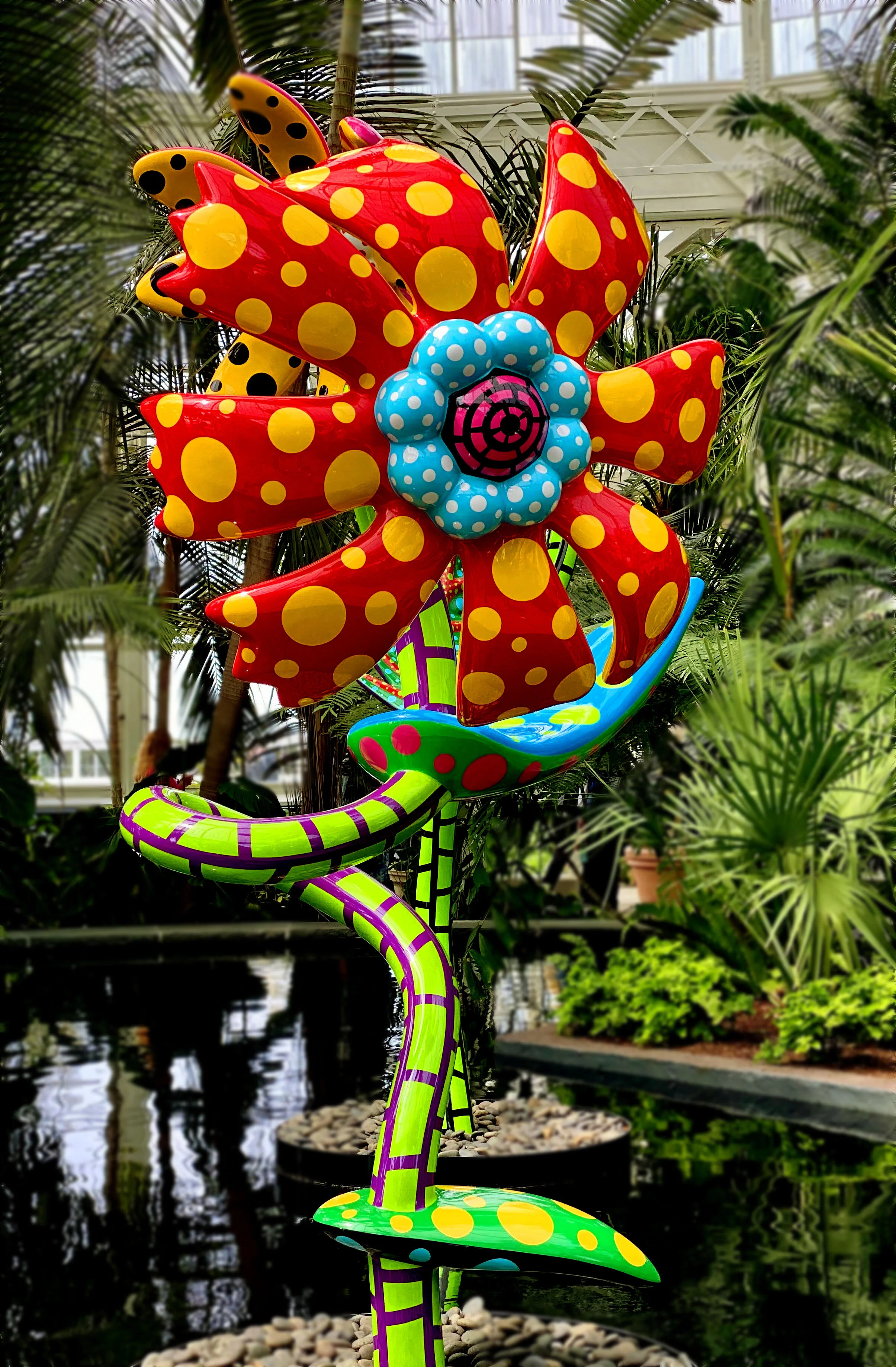Kusama: Les Fleurs du mal
Yayoi Kusama, My Soul Blooms Forever (2019)
by Irina Sheynfeld
Yayoi Kusama (b.1929) is perhaps one of the most misunderstood artists alive today. Her work is often described as cheerful, playful, and optimistic when it is anything but. In his article for The New York Times, Will Heinrich wrote, “Kusama’s hard-edge, comparatively cold polka dots bring out the plants’ dark side, their relentless, impersonal compression of growth, sex and decay.”
A stunning show of the artist’s work Kusama: Cosmic Nature is now on view at the New York Botanical Garden in the Bronx. Kusama’s sculptures are scattered throughout the 250-acre landscape transforming the Garden into a fantastic scene, far removed from reality. Although her recent work such as Dancing Pumpkin (2020) and My Soul Blooms Forever (2019), may appear to a casual observer sunny and life-affirming, the root of Kusama’s practice stems from the place of terror, hallucinations, and the impulse for self-obliteration. Kusama developed her visual language when she was still a very young artist working in the mountains of Nagano. The signature dots and infinity nets can be seen in her earliest surviving pieces such as Pistils Swaying in the Wind (1978), which is part of the small but comprehensive retrospective in LuEsther T. Mertz Library Building. In Yayoi Kusama's 2012 monograph from Rizzoli, Arthur Lubow compares the artist’s early painting to the work Edward Munch made in the 1930s, Abstract, Optical Illusions from the Eye Disease (1930), which he did while suffering from a burst blood vessel in the right eye. Lubow argues that the aura of suffering and obsession is similar for both artists.
Yayoi Kusama, Pistils Swaying in the Wind (1978)
Kusama grew up in the countryside, where her parents owned a large seed nursery. As a young artist, she didn’t have a lot of formal training – her parents didn’t encourage her artistic ambitions, but she was always drawn to plants and her earliest surviving drawings are detailed studies of flowers. Opening blossoms for Kusama then and now are pure expressions of desire – they are sexual organs liberated from reason and rationality. Her monumental sculptural composition Hymn of Life—Tulips (2007) is astonishing: large, phallic, and dizzyingly bright, hungry tulips come out of the Conservatory Courtyard Hardy Pool. In Kusama’s signature style they are obliterated by the obsessive pattern of dots. The relentless parade of circles goes back to the artist’s practice of self-annihilation, which, paradoxically, coincides with her other life’s ambition of being a star.
Yayoi Kusama, Starry Pumpkin, from 2015, is set in a specially designed flowerbed that will be updated for the seasons.
The public sculpture has been part of Kusama’s practice since the mid-1990s. Especially interesting is the artist’s engagement with pumpkins. In her chapter “Large Sculpture” in Kusama, Leslie Camhi writes that the artist, “vividly recalls the first time she ever saw a pumpkin, when as a young child she accompanied her grandfather to the vast, seed-harvesting grounds near her home in Matsumoto, Japan.” “I stopped to lean in for a closer look,” she writes in her autobiography, Infinity Net, “and there it was: a pumpkin the size of a men’s head. I parted a row of zinnias and reached in to pluck the pumpkin from its vine. It immediately began speaking to me in a most animated manner.” We do not know what did pumpkin tell Kusama, but a long chain of magical gourds is still coming our way from Japan. One of the earliest examples, a yellow vegetable dotted with black circles that emphasize its shape, Pumpkin, was installed on Naoshima Island, a remote art center located on Japan’s Seto Inland Sea, in 1994. The latest specimen is a large octopus-like creature Dancing Pumpkin (2020). The giant vegetable is finally unmoored. The sculpture is slick and exquisite, it is simultaneously beastly, free, and full of hallucinogenic joy; like a lucid dream of the pipe-happy caterpillar from Wonderland.
Yayoi Kusama, Dancing Pumpkin (2020)
While Kusama’s monumental sculptures were not conceived as jovial characters fit for the life on Sesame Street, the inspired garden installation gives new life and new meaning to the artist’s carnal creations. Here in the garden, the context becomes part of the art. Kusama’s works are stripped of their dark sources and become Disney-like sanitized versions of themselves. They fulfill our shred desire to leave the Covid-winter blues behind and to enter the world of spring, joy, and renewal. Like Little Mermaid who gets to marry the prince and sing the song, Kusama’s tulips are no longer tortured, suicidal phalluses, but dynamic sculptures irresistible in their lightness and charm. Camhi concludes her essay on Kusama’s late work by recalling the story of the six legendary ginkgo trees that were among the few survivors of the atomic blast on Hiroshima, and are still alive today. “In this sense,” Camhi goes on, “Kusama’s sculptures, the late blossoming of her ever-fertile mind, will long outlast her, to bloom perpetually in the light of day.”
Photo credit: Anna Gross and Irina Sheynfeld
Yayoi Kusama, My Soul Blooms Forever (2019)
Both the springtime and its verdure
So mortified my heart
That I punished a flower
For the insolence of Nature.
Thus I should like, some night,
When the hour for pleasure sounds,
To creep softly, like a coward,
Toward the treasures of your body,
To whip your joyous flesh
And bruise your pardoned breast,
To make in your astonished flank
A wide and gaping wound,
And, intoxicating sweetness!
Through those new lips,
More bright, more beautiful,
To infuse my venom, my sister!
Charles Baudelaire (1821 - 1867), Les Fleurs du mal (Flowers of Evil)
Magpie’s team in the artist’s first-ever obliteration greenhouse, Flower Obsession (2017/2021)
Irina Sheynfeld, Friday Afternoon, 2021








